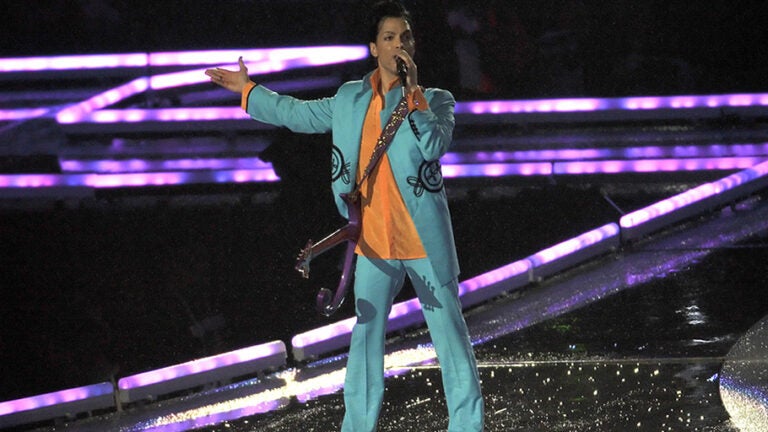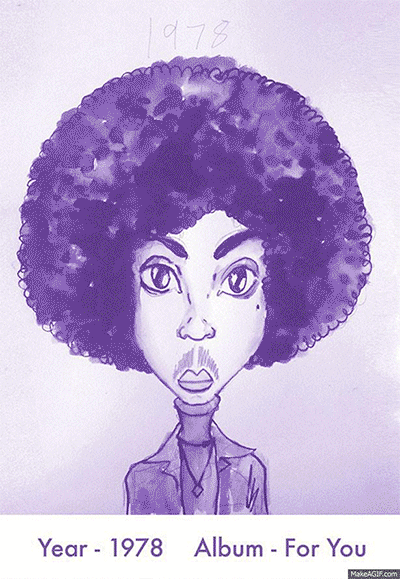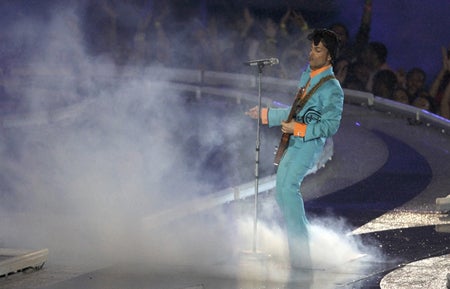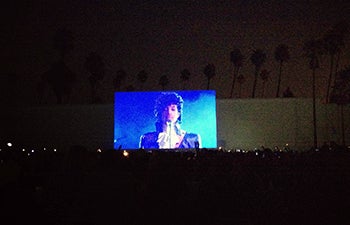
Remembering Prince, virtuoso and provocateur
Dearly beloved
We are gathered here today
To get through this thing called life
So begins Prince’s song “Let’s Go Crazy,” which opens the 1984 film Purple Rain. The movie, in which he starred as famed Minnesota musician The Kid from a troubled home, was a fictionalized version of his life. The track hit No. 1 on the Billboard Hot 100 that year, as did “When Doves Cry,” another single from the soundtrack — itself No. 1 on the charts.
Now music fans everywhere must come to terms with life without Prince. He passed away on April 21 in his home in Chanhassen, Minn. He was 57.
So far, 2016 has been a tough year for music fans. Earlier this year David Bowie passed away at age 69, as did Merle Haggard (79), Glenn Frey (67), Frank Sinatra Jr. (72) and Maurice White of Earth, Wind and Fire (74), among many other notable artists.

Designer and illustrator Gary Card demonstrates Prince’s ever-changing style on his album covers. Animated gif used with permission from Gary Card.
To say that Prince was a musical prodigy is no exaggeration. He is reported to have mastered at least 27 instruments, all of which he played on his 1978 debut album For You. He continued to play and record the majority of his music himself throughout his career.
Prince was an electrifying performer and a prolific songwriter whose music spanned genres — he easily moved between rock and roll, pop music, R&B and funk. He not only penned works that he made famous but also songs that became top hits for other musicians including “Nothing Compares 2 U” performed by Sinead O’Connor, “How Come You Don’t Call Me Anymore,” performed by Alicia Keys, and “I Feel for You,” performed by Chaka Khan.
He was known for playing with ideas of gender, in his appearance and in his music, and for his frank depictions of sexuality — subtly in songs like “Little Red Corvette” and blatantly in “Darling Nikki,” which prompted the creation of parental advisory stickers.
Prince fought to carve out a space for himself in the music industry, where he craved freedom from the restrictions he felt that the business models imposed on him. In the 1990s, he famously took on his label, Warner Bros. Records, seeking to be released from his contract. The friction led him to change his name for a period of time to a symbol, eliciting the moniker “The Artist Formerly Known as Prince.” He also resisted online markets, bothered by the ease of unfettered — and unpaid — access to his music.

Prince performs during half-time for Super Bowl XLI between the Chicago Bears and the Indianapolis Colts at Dolphin Stadium on Feb. 4, 2007 in Miami. Photo by Anthony Correia.
Prince, a fearless style icon whose signature color was purple, was born Prince Rogers Nelson in Minneapolis, Minn., on June 7, 1958. Upon hearing of his passing, fans in his hometown — many wearing purple — gathered for an all-night party at the First Avenue nightclub in Minneapolis, where much of Purple Rain was filmed.
There were many other tributes around the world. The city hall buildings in both Los Angeles and San Francisco were illuminated with purple lights, as was the Mercedes-Benz Superdome in New Orleans. Los Angeles County Museum of Art’s famed Rain Room turned purple for the day. The cast of Broadway’s “The Color Purple” closed out their April 21 show with a wrenching performance of “Purple Rain” and “Let’s Go Crazy.”
Even President Obama praised Prince’s talents in a statement: “Few artists have influenced the sound and trajectory of popular music more distinctly, or touched quite so many people with their talent. As one of the most gifted and prolific musicians of our time, Prince did it all. Funk. R&B. Rock and roll. He was a virtuoso instrumentalist, a brilliant bandleader and an electrifying performer.”
It’s no surprise that Prince’s passing has affected so many so much. Neuroscientist Mary Helen Immordino-Yang, associate professor of education, psychology and neuroscience at USC, explained, “Music triggers powerful emotions, and music sets the emotional context for many of the important events of our lives.”
For those who grew up listening to Prince’s music, there’s actually a deep-rooted mind-music connection at work.
“Because music plays such a central role in both informal and ceremonial aspects of human culture, specific artists, genres and pieces of music often have the power to trigger vivid episodic memories — highly personal and meaningful recollections of experienced events and relationships.”
And as recent Pulitzer Prize winner Viet Thanh Nguyen, associate professor of English and American studies and ethnicity, succinctly summed up on Twitter: “The @Prince is dead, but his music lives forever. That’s all any artist could want.”
Here, more USC Dornsife faculty reflect on the purple one’s legacy.
Ange-Marie Hancock, associate professor of political science, gender studies and sociology, recalls Prince as a champion for female musicians:
One of Prince’s most important legacies is his record of collaborating with and promoting a wide variety of female pop artists. He was one of the first prominent music stars to hire female musicians who were more than backup singers. He hired Wendy Melvoin as a guitarist and Sheila Escovedo — Sheila E. — as a percussionist, and later as musical director. When Lenny Kravitz hired a female drummer nearly 15 years later, it was still considered a novelty.
Prince’s prodigious songwriting also launched or re-launched the careers of Chaka Khan, Sinead O’Connor, Sheena Easton, Joan Osborne and many other artists. So, he was ahead of his time in support of female musicians.
Her experiences seeing Prince perform live:
Prince’s concert performances were indeed legendary. I saw him in concert three times in three decades: The Purple Rain Tour in 1985; in 1994; and in 2003 in Maui. In 1994, I had the privilege of seeing him perform at his Minnesota home, Paisley Park, as part of a private party he hosted during NBA All-Star Weekend. The level of virtuosity and generosity in the performance, which started at about midnight and continued until about 5 a.m., included jam sessions with young artists like Tevin Campbell, who also benefited from Prince’s music production expertise. Prince was always able to simultaneously be authentically himself and to anticipate musical trends.
Hancock on Prince’s social activism:
Prince’s social impact was felt in ways that many might overlook in today’s artists. Younger fans might know that Prince wrote a song, “Baltimore,” following protests regarding the death of Freddie Gray, but his social commentary goes back at least 30 years with songs like “Sign O’ the Times,” “Money Doesn’t Matter 2 Night” and even a party song like “Let’s Go Crazy.” He was one of the few American crossover stars to be able to blend the traditional theme of rock and roll with both political and spiritual commentary into a single song that seemed to always end up dominating the charts.
Clifford Johnson, professor of physics and astronomy, on NASA’s tribute to Prince, a photo of the purple Crab Nebula “a bright star that died out, burning bright and fast before it did”:
It’s an often overused metaphor, the star that burns brightly and not for long — but I can see why in this case it is fitting. We should not look too closely at the metaphor, however, since the details are quite different: The Crab Nebula is what is left over after a star, which had a regular life for a long time, then ended in a huge, bright explosion that outshone other stars. I’d say Prince was doing a lot of outshining all along his career, not just for a short bright event at the end.
Johnson on Prince’s cultural legacy:
First and foremost for me is his remarkable transcendence of boundaries. Most obviously, but not limited to, musical genres. He was completely unclassifiable when he first showed up, and arguably he still is today. So many of the genre-defying musicians who are getting a lot of attention in recent times owe a great debt to him. He really blazed the trail — especially when you put race into the mix.

Prince. Photo by Nicholas Genin.
There’s an important aspect of Prince pertaining to race that is hugely important to note. I’m not the first to say it, but it bears repeating. He was one of the early pioneers of championing a black man’s right to be just plain weird if he wanted to be. The right for a black person to walk a different path and not have their race define them in the eyes of others. He did that with his music and much of what he did beyond that, too, and I think he helped make that freedom part of the broader culture. I wish it were an even bigger part of the culture than it is, but he was one of the people who got us as far as we have come as a culture on that issue.
On his favorite Prince songs:
There are far too many great ones to choose a favorite from! Let me mention three: “Kiss,” “1999,” and “I Feel For You.” The last is not well known as a Prince song, but it is, and a great one at that. Why those? Back when I first heard them, and even now, there was something uniquely infectious about them. Partly because nothing else sounded like them, which can be said about so many of his songs, and partly because they were just so odd and beautiful at the same time.
On catching one of Prince’s performances during his 2011 21-Night Stand residency at the Forum in Inglewood:
The show I attended was on May 27. There was so much energy in the crowd and on stage when he appeared. It was a huge event for everyone around me. He made you feel like he cared that you had a good time. He put his heart and soul into everything he did, and he was so generous with numerous encores and musical guests long into the night. I’ve never seen another performer of that stature give so much music to an audience in one night. Rumor has it he and the band played again for hours at an after party… And that was part of a long series of consecutive engagements at the Forum over three weeks!
Chris Freeman, professor (teaching) of English, on Prince’s singular appeal:
For the generation who came of age in the ’80s, Prince was like David Bowie for the people a little older than us — transgressive, sexy, edgy and mercurial. I especially remember “Kiss,” which had such a sexual essence, and “Raspberry Beret,” which had an escapist lightness. The film Purple Rain was heavy and operatic; the entourage at the Academy Awards that year showed the influence of my idol, Stevie Nicks, whose hit song “Stand Back” was inspired by the rock drive of Prince’s “Little Red Corvette.” Some of Prince’s style and look at the award show was an homage to Stevie, consciously or not. But he was singular; he was iconic; he’s that rare public figure about whom we know way less than we think, and that is very appealing. There will never be another Prince.
Alice Echols, Barbra Streisand Professor of Contemporary Gender Studies and professor of history and gender studies, on Prince’s musical style and sexuality:
Prince challenged what were in the late ’70s racially inflected musical categories. Like Sly Stone, the musician whose footsteps he followed in, he refused to abide by notions of what counted as R&B or funk or rock. His music was a thrilling mash-up of styles, and like Sly Stone, he assembled an eclectic band of musicians — both men and women.
Prince was unabashedly sexual, and in ways that made some uncomfortable. Think of the picture of him on his breakthrough LP, Dirty Mind, dressed in black bikini briefs and a jacket. Or those pants — the cheeks-revealing pants — that he wore on MTV’s 1999 Video Music Awards. Fey styles were his style (“I’m not a woman, I’m not a man/I am something that you’ll never understand,” he sang in “I Would Die 4 U”) and he was coy at first about his sexuality (“am I straight or gay” he teased on “Controversy”).

Moviegoers at Cinespia’s screening of Purple Rain at the Hollywood Forever Cemetery in 2014 hold up their cell phones like lighters as Prince begins to perform the film’s eponymous song. Photo by Michelle Boston.
Prince didn’t just sing a song titled “Controversy,” he was also controversial. When Prince and his band The Revolution opened for the Rolling Stones on their 1981 tour, not all Stones fans were happy. At the Los Angeles Coliseum, fans turned so nasty, booing and hurling beer bottles at the band, that Prince and his band retreated after playing only 20 minutes. For fans of rock music, who were still angry about disco’s recent dominance of the charts, Prince’s music, danceable, beat-heavy, synthesizer-driven, was too redolent of glitter-ball music. And Prince, who came across as more omnisexual than anything, seemed to some suspiciously unmasculine. Like David Bowie, Prince staked a claim for unconventionality of all kinds. As a culture, we are so much the better for it.
Manuel Pastor, Turpanjian Chair in Civil Society and Social Change and professor of sociology and American studies and ethnicity, on the economic and social climate of the U.S. when Prince’s popularity soared, and his creative legacy:
Prince emerged in the 1980s, a time in which the right was on the rise, the economy was on the fall, and lines were being drawn. Bursting out with songs like “Controversy” and “Uptown,” he was like a hopeful nod to the future waiting to be born: ambiguous in his sexuality, multicultural in his music and fluidly moving across every boundary, he presaged who we were hoping to become.
His creativity stretched across the usual divisions. He was one of the first to effectively wed music and video, setting the standards for the generations to come. And the music alone was not music alone: The striking beats and confessional tone of songs like “When Doves Cry” offered us art at its most personal and its most vibrant while the biting commentaries of “1999” or “Sign O’ the Times” offered us social analysis at its sharpest.
Like many musicians, he was ensnarled in contracts that stripped what he thought were his rights. And his struggle to assert control over his master recordings — finally won when he gave up on lawyers and hired a former labor organizer (and my friend) Phaedra Ellis-Lamkins — showed what could happen when you blend a social justice ethos and will to fight with a fierce commitment to artistic control and creativity.
Nothing compared – or compares.
Karen Tongson, associate professor of English and gender studies, on Prince’s exceptional ability to capture the human condition:
Prince’s death seems almost unfathomable, given how much his music and performances were so radiant with life and something almost, already otherworldly. His music soundtracked my coming of age, just as I was just becoming aware of myself as a desiring being and trying desperately not to be frightened by the power of those forces. His music unfolded a range of experiences throughout my life mixed with joy, confusion, passion, possibility and the urgency to live a life during which we should all give ourselves the room to “go crazy” lest tomorrow never come.